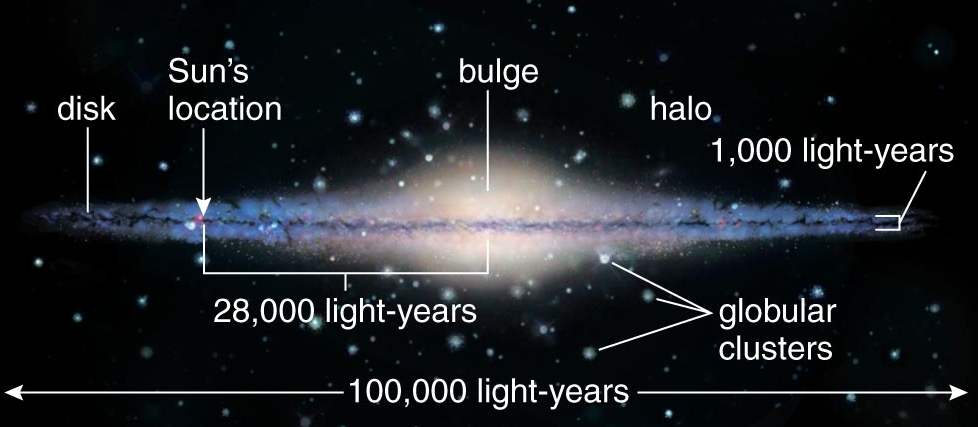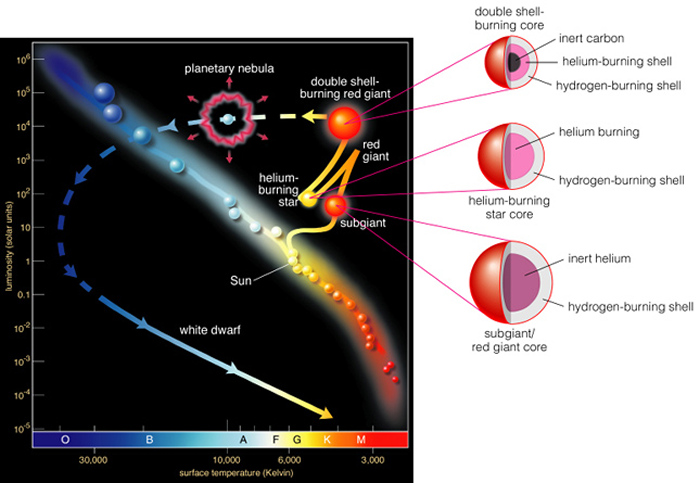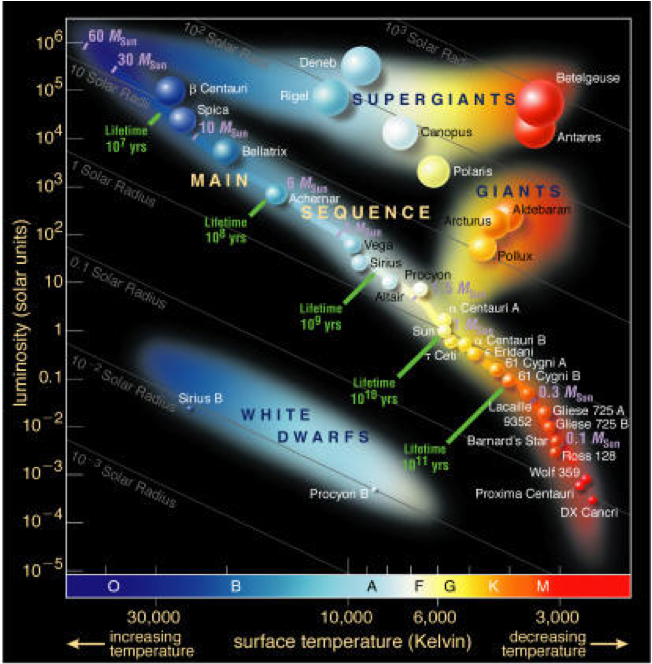Cards In This Set
| Front | Back |
|
Sketch Edge on view of milky way.
|
 Disk, Sun, Bulge, Halo and globular clusters outside. 28,000 LYs from sun to bulge. and 100,000 for entire thing |
|
Five methods astronomers use to determine distance?
|
• Radar ranging- we measure the Earth-Sun distance by bouncing radio waves off planets and using some geometry
• Parallax- measure distances to nearby stars by observing how their positions change, relative to the background stars, as Earth orbits the Sun. These distances rely on our knowledge of the Earth-Sun distance, determined with radar ranging to planets • Main-sequence fitting- Comparing the apparent brightness of star clusters whose distance is determined by parallax to those main sequence stars in other clusters gives us the distances to these other star clusters in our galaxy. • Cepheid variables- by studying Cepheids in star clusters with distances determined by main-sequence fitting we learn the precise period-luminosity relation for Cepheids. When we find a Cepheid in a more distant galaxy we can determine its luminosity by measuring the period between its peaks in brightness and then use this luminosity to determine the distance • Distant standards- by measuring distances to relatively nearby galaxies with Cepheids we learn the true luminosity of white dwarf supernovae and other distant standard candles, enabling us to measure great distances throughout the universe |
|
Mechanisms that restrict mass range of stars?
|
Low mass limit is set by the resistance to graitational cotraction provided by electron degeneracy pressure. Stars less than .1 SM do not have enough gravity to compress their cores to high enough temp to begin nuclear fusion. High end is set by radiation pressure as stars more massive than 100 Sm produce so much light that they blow off their outer atmospheres.
|
|
HR diagram which shows evolution of 1 SM star?
|
 Full marks were given for a simple version of the diagram below, which showed the location of the main sequence (H core fusion), red giant branch (RGB, or shell H fusion), horizon- tal branch (HB, or core helium burning), asymptotic giant branch (AGB, or double shell burning), planetary nebular and white dwarf stages of evolution for a one solar mass star |
|
Two ways astronomers learn about interior of sun?
|
2. When observing the Sun’s surface, astronomers see sound waves that have traveled deep within the Sun. Astronomers learn about the sound speed and other characteristics of the various layers within the Sun by studying the observed frequencies of these sound waves.
3. Observations of solar neutrinos provide us with data about fusion which is occurring within the Sun’s core. |
|
Draw an HR diagram>?
|
 See pic |
|
Advantages of telescope over human eye?
|
The two principal advantages of a telescope over the human eye is its improved angular resolution and larger light collecting area.
The wavelike nature of light makes it impossible for the human eye to distinguish objects which are less than about 50 arc-seconds apart. A telescope, with its larger diameter lens (or mirror), is able to resolve objects which are much closer together (1 arc-second or less) so that the image shows greater detail than visible to the human eye. Telescopes have much larger lenses (or mirrors) compared to the human eye, allowing them to collect more light. This allows astronomers to see fainter objects. |
|
Properties determind by a spectrum?
|
Astronomers can determine the temperature, composition, velocity along the line of sight, and rotation rate of a star by analyzing its spectrum.
The temperature of the star can be found by comparing the spectrum to a blackbody (thermal) radiator. The peak wavelength of emission is inversely related to temperature. The composition of the star may be found by examining the absorption lines. Every element has a unique emission/absorption line spectrum. The velocity along the line of sight (speed away/towards us) may be found by examining the location of the absorption lines. Due to the Doppler effect, the wavelengths of the lines will be shifted to the red if the object is moving away from us, and to the blue if the object is moving towards us. The greater the amount of the shift, the larger the speed of the object. Finally, by examining the width of the absorption lines (how spread out they appear), astronomers can determine the rotation rate of a star. This is because we see light from the entire disk of the star, part of which is rotating towards us (blue-shifting the light) and other parts are rotating away from us, red-shifting the light. The wider the spectral lines, the faster the speed of rotation. |
|
Lived on moon near the center, what would you see with a total lunar eclipse on Earth?
|
During a total lunar eclipse as seen from the Earth, on the Moon you would see Earth pass in front of the Sun and it would be completly dark. The Moon would be in the umbra shadow of the Earth. Since the Earth is much larger than the Moon and the Moon rotates much slower than the Earth, the total solar eclipse would last for a long time (around 100 minutes). During this time, you would not be able to see the Sun’s corona since from the Moon the Earth appears much bigger in the sky than the Sun.
|
|
Astronomers discover earth mass planet orbiting at a dist of 4AU from a star with the same mass. What is orbital Period?
|
Kepler’s third law relates the orbital period of a planet to its distance from the Sun,and is valid in the solar system.
Therefore P^2 = a^3 = 4 × 4 × 4 = 64 and so P = sq rt (64) = 8 years. |
|
Earth axis changes tilt from 23.5 to 40 degrees but earth orbit does not change around sun.
|
The seasons would become more extreme, with hotter summers and colder winters. The seasons are caused by the tilt of the Earth’s axis – when we are pointing towards the Sun, sunlight falls more directly on the Earth’s surface making it warm. If the tilt were greater, then the Sun’s rays would be more vertical in the summer time, leading to hotter summers. In the winter time, the Sun would be lower in the sky and the Sun’s rays would hit Hanover at a shallow angle, leading to colder winters.
|
|
Simple sketch showing relative location of sun, earth moon when the moon is full.
|
The Moon reflects the Sun’s light. When the Mon is directly behind the Earth in relation to the Sun, an entire hemisphere of its surface (ie. half of its total surface) reflects sunlight towards the Earth and we see a full Moon.
|
|
In point form, list the five major life stages of a high-mass star, starting with the onset of nuclear fusion. For each life stage, describe how the star produces its energy.
|
(a) Main Sequence: Hydrogen fuses into Helium in the core
(b) Red Supergiant: Hydrogen fuses into Helium in a shell around the Helium core (c) Helium-burning Supergiant: Helium fuses into carbon/oxygen in a core while Hydrogen fuses into Helium in a shell (d) Multiple-shell burning Supergiant: Many elements fuse into other elements in multiple shells (e) Supernova Explosion: Core collapses and releases large amount of gravitational potential energy which causes the outer layers of the star to explode,leaving behind a neutron star or black hole. |
|
Describe what would happen to a white dwarf which accretes mass from a nearby red giant star, such that the white dwarf’s mass exceeds 1.4 solar masses. Write in complete sentences.
|
When a white dwarf exceeds 1.4 solar masss, electron degeneracy pressure can no longer support the white dwarf. It starts to collapse, and as it collapses it heats up leading to explosive fusion of carbon and oxygen. The fusion ejects so much energy into the white dwarf that it explodes into a white dwarf supernova.
|
|
Imagine that you are in a spaceship orbiting at a safe distance from a black hole. What would you see if your friend (in another ship) plunged into the black hole?
|
As my friend approached a black hole, I would see his/her time running slower and slower and the light coming from him/her would be redshifted. The closer s/he got to the event horizon, the slower time would run. I would never see him cross the event horizon, but he would disappear from view when his light became redshifted out of the range of detection. If s/he was approaching a stellar mass black hole, tidal forces would stretch his/her body and kill him/her.
|



